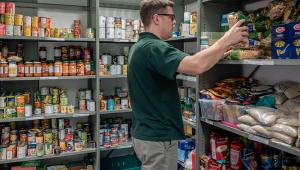Of the 14.2 million, 4.5 million children and 8.4 million working-age adults were in poverty in 2016-17, according a report from the Social Metrics Commission published on Monday.
It also found 7.7 million people were living in “persistent poverty” – people who had spent all or most of the last four years (and more) in poverty.
The commission, set up two years ago to inform policymakers on poverty, said its “new approach” measurement includes “inescapable costs” such as rent, mortgage payments, childcare and disability costs.
In 2010 Labour set the definition of “relative poverty” with the Child Poverty Act as living on less than 60% of the median average household income (before housing costs).
Conservative peer Philippa Stroud, who set up the commission and is now the chair, said she established the body “with the sole aim of developing of measures of poverty for the UK”.
This was because “much of the last decade of political and policy debate on and policy debate on poverty has focused on whether and how we should measure poverty,” she wrote.
The poverty measurement also looked at factors that have a positive impact of people’s spending power, such as liquid assets including savings, stocks and shares.
It found “far fewer pensions are living in poverty than previously thought”, the organisation found, with poverty rates among pension-age adults nearly halving since 2001 (falling from 20.8% in 2001 to 11.4% in 2017).
The research revealed that 68% of people living in workless families were in poverty last year, compared to 9% of people living in families where all adults work full time.
Stroud said the debate over how to measure poverty had been going on for “too long”.
“Now I call on people and organisations across, and outside of, the political spectrum to support this new measure of poverty so that we can all put our energy into creating the policies and solutions that build pathways out of poverty,”
Leon Feinstein, director of evidence at the Office of the Children’s Commissioner and SMC commissioner, said: “The work undertaken by the SMC has improved the accuracy of estimation of levels and types of poverty, focusing better than previous measures on the experience of poverty.
“By taking childcare and other needs into account the work of the commission has shown a greater level of poverty for children, which has hitherto been hidden.”
Helen Barnard, head of analysis at the JRF and SMC commissioner, said: “[The new measurement] gives us a clearer picture of who is in poverty and highlights the importance of housing and childcare costs in sweeping people into poverty, and the protection that savings can provide.
“We call on the government, the Office for National Statistics and all of those working to solve poverty, to support this new measure of poverty”.
A government spokesperson said: “Measuring poverty is complex, and this report offers further insight into that complexity and the additional measures that can be taken into consideration.”
The spokesperson added: “We continue to spend £90bn a year on working age benefits to provide a safety net for those who need it when they need it, and we will be spending £54bn this year, more than ever before, to support disabled people and those with health conditions.”
Organisations represented within the commission include the Joseph Rowntree Foundation, the Institute for Fiscal Studies, the Education Policy Institute and YouGov.
In July, the Resolution Foundation think-tank estimated that the proportion of children in poverty grew by 21% between 2011 and 2016, despite the government calculating growth of 11%.











